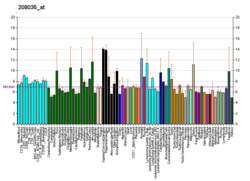Metabotropic glutamate receptor 6
Glutamate receptor, metabotropic 6, also known as GRM6 or mGluR6, is a protein which in humans is encoded by the GRM6 gene.[5][6]
Function
L-glutamate is the major excitatory neurotransmitter in the central nervous system and activates both ionotropic and metabotropic glutamate receptors. Glutamatergic neurotransmission is involved in most aspects of normal brain function and can be perturbed in many neuropathologic conditions. The metabotropic glutamate receptors are a family of G protein-coupled receptors, that have been divided into 3 groups on the basis of sequence homology, putative signal transduction mechanisms, and pharmacologic properties. Group I includes GRM1 and GRM5 and these receptors have been shown to activate phospholipase C. Group II includes GRM2 and GRM3, while Group III includes GRM4, GRM6, GRM7 and GRM8. Group II and III receptors are linked to the inhibition of the cyclic AMP cascade but differ in their agonist selectivities.[5]
mGluR6 is specifically expressed in the retina, in a subtype of bipolar cells that depolarize in response to light, known as ON bipolar cells. These cells form synapses with photoreceptor cells, and detect the neurotransmitter glutamate via a GPCR signal transduction cascade. The glutamate receptor mGluR6 is located post-synaptically at the tips of the bipolar cell dendrites, and is responsible for initiating a signaling cascade that ultimately controls gating of the TRPM1 channel.[7][8] In human patients, mutations in the GRM6 gene are associated with congenital stationary night blindness.[9][10]
See also
References
- GRCh38: Ensembl release 89: ENSG00000113262 - Ensembl, May 2017
- GRCm38: Ensembl release 89: ENSMUSG00000000617 - Ensembl, May 2017
- "Human PubMed Reference:". National Center for Biotechnology Information, U.S. National Library of Medicine.
- "Mouse PubMed Reference:". National Center for Biotechnology Information, U.S. National Library of Medicine.
- "Entrez Gene: GRM6 glutamate receptor, metabotropic 6".
- Hashimoto T, Inazawa J, Okamoto N, Tagawa Y, Bessho Y, Honda Y, Nakanishi S (June 1997). "The whole nucleotide sequence and chromosomal localization of the gene for human metabotropic glutamate receptor subtype 6". Eur. J. Neurosci. 9 (6): 1226–35. doi:10.1111/j.1460-9568.1997.tb01477.x. PMID 9215706.
- Nakajima Y, Iwakabe H, Akazawa C, Nawa H, Shigemoto R, Mizuno N, Nakanishi S (1993). "Molecular characterization of a novel retinal metabotropic glutamate receptor mGluR6 with a high agonist selectivity for L-2-amino-4-phosphonobutyrate". J Biol Chem. 268 (16): 11868–73. PMID 8389366.
- Masu M, Iwakabe H, Tagawa Y, Miyoshi T, Yamashita M, Fukuda Y, Sasaki H, Hiroi K, Nakamura Y, Shigemoto R, Takada M, Nakamura K, Nakao K, Katsuki M, Nakanishi S (1995). "Specific deficit of the ON response in visual transmission by targeted disruption of the mGluR6 gene". Cell. 80 (5): 757–65. doi:10.1016/0092-8674(95)90354-2. PMID 7889569.
- Dryja TP, McGee TL, Berson EL, Fishman GA, Sandberg MA, Alexander KR, Derlacki DJ, Rajagopalan AS (2005). "Night blindness and abnormal cone electroretinogram ON responses in patients with mutations in the GRM6 gene encoding mGluR6". Proc Natl Acad Sci U S A. 102 (13): 4884–9. Bibcode:2005PNAS..102.4884D. doi:10.1073/pnas.0501233102. PMC 555731. PMID 15781871.
- Zeitz C, van Genderen M, Neidhardt J, Luhmann UF, Hoeben F, Forster U, Wycisk K, Mátyás G, Hoyng CB, Riemslag F, Meire F, Cremers FP, Berger W (2005). "Mutations in GRM6 cause autosomal recessive congenital stationary night blindness with a distinctive scotopic 15-Hz flicker electroretinogram". Invest Ophthalmol Vis Sci. 46 (11): 4328–35. doi:10.1167/iovs.05-0526. PMID 16249515.
Further reading
- Hashimoto T, Inazawa J, Okamoto N, et al. (1997). "The whole nucleotide sequence and chromosomal localization of the gene for human metabotropic glutamate receptor subtype 6". Eur. J. Neurosci. 9 (6): 1226–35. doi:10.1111/j.1460-9568.1997.tb01477.x. PMID 9215706.
- Dhingra A, Lyubarsky A, Jiang M, et al. (2001). "The light response of ON bipolar neurons requires G[alpha]o". J. Neurosci. 20 (24): 9053–8. doi:10.1523/JNEUROSCI.20-24-09053.2000. PMC 6773027. PMID 11124982.
- Valerio A, Ferraboli S, Paterlini M, et al. (2001). "Identification of novel alternatively-spliced mRNA isoforms of metabotropic glutamate receptor 6 gene in rat and human retina". Gene. 262 (1–2): 99–106. doi:10.1016/S0378-1119(00)00547-3. PMID 11179672.
- Dryja TP, McGee TL, Berson EL, et al. (2005). "Night blindness and abnormal cone electroretinogram ON responses in patients with mutations in the GRM6 gene encoding mGluR6". Proc. Natl. Acad. Sci. U.S.A. 102 (13): 4884–9. Bibcode:2005PNAS..102.4884D. doi:10.1073/pnas.0501233102. PMC 555731. PMID 15781871.
- Zeitz C, van Genderen M, Neidhardt J, et al. (2005). "Mutations in GRM6 cause autosomal recessive congenital stationary night blindness with a distinctive scotopic 15-Hz flicker electroretinogram". Invest. Ophthalmol. Vis. Sci. 46 (11): 4328–35. doi:10.1167/iovs.05-0526. PMID 16249515.
- Zeitz C, Forster U, Neidhardt J, et al. (2007). "Night blindness-associated mutations in the ligand-binding, cysteine-rich, and intracellular domains of the metabotropic glutamate receptor 6 abolish protein trafficking". Hum. Mutat. 28 (8): 771–80. doi:10.1002/humu.20499. PMID 17405131.
This article incorporates text from the United States National Library of Medicine, which is in the public domain.




